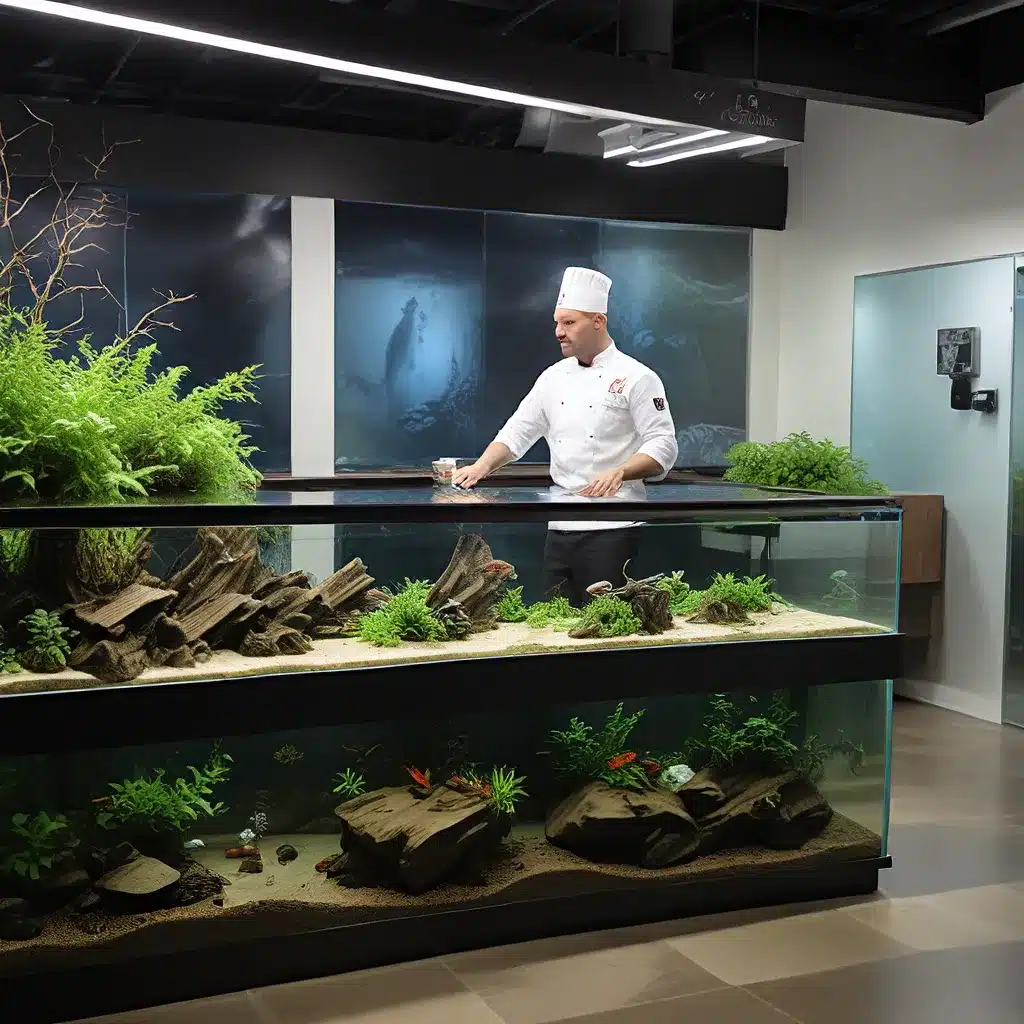
In the vibrant world of aquarium keeping, the art of aquascaping has become a true culinary delight for the senses. Just as a skilled chef crafts a visually stunning and flavorful dish, aquascape enthusiasts masterfully arrange their underwater gardens to create captivating, harmonious displays. Drawing inspiration from nature and the principles of design, these aquatic artists elevate the humble aquarium into a captivating centerpiece that nourishes the soul.
Laying the Groundwork: Selecting the Right Ingredients
The foundation of any exceptional aquascape begins with the choice of aquarium inhabitants. Just as a chef carefully selects the freshest, most complementary ingredients, the aquascaper must thoughtfully consider the specific fish, plants, and invertebrates that will thrive in their designed ecosystem. King Aquarium offers a vast array of species, each with unique requirements and characteristics that can be leveraged to create a visually stunning and biologically balanced aquatic scene.
Researching the needs and preferences of potential aquarium residents is crucial to ensuring their long-term health and the overall success of the aquascape. From the delicate Chili Rasbora and the Freshwater Shrimp to the majestic Discus and the vibrant Dwarf Gourami, each species has its own set of water parameters, feeding habits, and social dynamics that must be meticulously considered. By understanding these nuances, aquascape enthusiasts can curate a harmonious community that will not only captivate the eye but also thrive in their carefully crafted underwater oasis.
Artful Arrangement: Composing the Aquatic Canvas
With the right inhabitants selected, the next step in creating an exceptional aquascape is the thoughtful arrangement of the aquatic elements. Just as a chef arranges the components of a dish to create a visually appealing and balanced presentation, the aquascaper must consider the principles of design to craft a cohesive and visually captivating underwater landscape.
Utilizing the rule of thirds, a fundamental concept in art and photography, aquascape enthusiasts can strategically position their plants, rocks, and driftwood to create a sense of depth and visual interest. By placing the focal points of the aquarium along the intersecting lines of an imaginary grid, the viewer’s eye is naturally drawn to the most captivating elements, creating a harmonious and visually striking composition.
Incorporating contrast and texture is another crucial element in crafting a remarkable aquascape. Just as a chef might juxtapose smooth and crunchy textures or blend complementary flavors, the aquascaper can use a variety of plant shapes, sizes, and colors to create visual interest and depth within the aquarium. The interplay of soft, flowing plants and rigid, sculptural hardscapes can evoke a sense of balance and tranquility, while the strategic use of color can imbue the aquascape with a sense of vibrancy and life.
Maintaining the Balance: Mastering Aquarium Husbandry
As with any culinary masterpiece, the true test of an aquascape’s excellence lies in its long-term sustainability. Just as a skilled chef must carefully monitor the freshness and quality of their ingredients, the aquascape enthusiast must be diligent in their water management and plant care to ensure the ongoing health and vitality of their underwater oasis.
Consistent water testing and partial water changes are essential to maintaining the delicate balance of the aquarium ecosystem. By closely monitoring parameters such as pH, temperature, and dissolved oxygen levels, aquarists can quickly identify and address any potential imbalances or water quality issues that could compromise the well-being of their aquatic inhabitants.
Furthermore, the judicious pruning and trimming of aquatic plants is crucial for promoting their growth and maintaining the desired aesthetic of the aquascape. Just as a chef might carefully trim and garnish a dish, the aquascape enthusiast must be attentive to the needs of their underwater flora, ensuring that the plants remain lush, vibrant, and in harmony with the overall design.
Inspiration and Innovation: Elevating the Aquatic Art Form
As the aquarium hobby continues to evolve, aquascape enthusiasts are pushing the boundaries of what is possible, drawing inspiration from the natural world and the culinary arts to create truly breathtaking underwater landscapes. From the serene, minimalist Iwagumi style to the lush, jungle-like Dutch aquascapes, the diversity of aquascaping approaches mirrors the rich tapestry of culinary traditions found around the globe.
| Aquascaping Style | Characteristics | Inspiration |
|---|---|---|
| Iwagumi | Minimalist, clean lines, focus on rock formations | Zen gardens, Japanese landscapes |
| Dutch | Lush, dense planting, diverse species, emphasis on vibrant colors | European garden design, botanical diversity |
| Biotope | Recreates a specific natural ecosystem, typically regional | Specific geographic locations and their native flora/fauna |
As aquascape enthusiasts continue to push the boundaries of their craft, the parallels between the culinary and aquarium worlds become ever more apparent. Just as innovative chefs experiment with novel flavor combinations and presentation techniques, aquascape artists are constantly exploring new ways to create captivating, sustainable underwater environments that delight the senses and nourish the soul.
Whether you’re a seasoned aquarist or a newcomer to the world of aquascaping, the principles of careful ingredient selection, thoughtful composition, and meticulous maintenance can elevate your aquarium into a true work of art. By embracing the lessons of the culinary world and the wonders of the natural aquatic realm, you too can become a master aquatic chef, crafting a gourmet aquarium that will leave your guests in awe and wonder.

